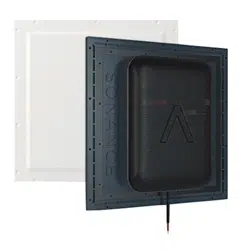Loading ...
Loading ...
Loading ...

17
FREQUENTLY ASKED QUESTIONS
Can Invisible Series speakers be installed in the ceiling
or just in walls?
Sonance IS speakers can be installed in both walls and
ceilings.
Where is the best place to locate the speakers?
If installing into walls, make sure they are at least 7’
(2.13m) from the floor. In ceilings, evenly space the
speakers for optimal coverage, and avoid corners if
possible. Contact Sonance Tech Support / Design
Services for help with speaker layout planning.
What is the minimum depth requirement?
Minimum depth without enclosure = ~2.75” (70mm)
Minimum depth with enclosure = ~3.5” (90mm)
Can IS speakers be used in a plenum space?
Only models with a “T” sux such as the IS8T are rated
for plenum use (UL2043). The standard models (IS6/
IS8/IS10/IS10W) are not plenum rated.
Can these speakers be installed in a T-Bar ceiling?
Theoretically yes. Consult with the manufacturer of the
T-Bar ceiling in question to ensure the max load is within
safe limits for the aggregate weight of the IS speakers
you wish to install.
Can these be used outside?
Sonance invisible speakers are not outdoor rated and
should not be used outside.
Can these be used in high heat or high humidity
applications?
Invisible speakers should not be directly exposed
to high heat or humidity. However you may use
finishing materials that are rated for high heat and
humidity exposure, provided that they form a barrier
that prevents exposure to the speakers. We highly
recommend you perform a mock-up trial of the finish
materials, speaker, and environment to validate the
performance long-term.
What finish materials can I use with invisible speakers?
Can these be covered with wallpaper or wood veneer?
Use flexible materials such as: slow-setting, lightweight
drywall compounds, wallpaper, wood veneer, vinyl
veneer, acrylic-based venetian plaster. See page 14 for
more details.
Are there materials that should not be used to cover
the speakers?
Any material that is sti, inflexible, or exceeds 3mm
(1/8”) in total thickness over the speaker diaphragm
such as tile, metal sheet, stone veneer, true Venetian
plaster, stucco, etc. These are not compatible with
invisible speakers. The stiness of materials like these
restrict movement and result in lack of bass and mued
sound.
How much finish material can go over the speaker?
We recommend 1.0mm to 1.5mm for optimal
performance. The maximum limit is 3mm (1/8”).
How can I tell how much finish material is covering the
speaker?
Use the Sonance DG-1 depth gauge (SKU 93491) to
measure actual finish thickness covering Sonance
invisible speakers.
What is the DISC system?
The Sonance DISC System provides a highly accurate
method for non-destructively quantifying the thickness
of a finish applied on top of a Sonance invisible speaker
diaphragm. The Sonance DG-1 handheld depth gauge
uses a magnetic sensor to measure the distance
between the top of the finished speaker and steel
discs embedded in all four corners behind the speaker
diaphragm of Sonance Motion Flex Invisible Speakers.
What if I add too much finish material?
Prior to the final finishing stage (such as painting),
sand down the wall or ceiling surface and measure the
finish thickness using the DG-1 depth gauge. Repeat
as necessary until you measure 3mm or less. We
recommend 1.0mm and 1.5mm for optimal performance.
Is there a benefit to “Finish Up To” rather than “Finish
Over”?
There is no practical benefit to a Finish Up To style
finish. In fact, we recommend Finish Over because it
typically takes less installation time and results in a
more seamless, shadowless final finish. Furthermore, IS
speakers are optimized for about 1.0mm to 1.5mm of
finish material for best performance.
What happens if the mud or finish cracks?
Mud/finish cracks are indicative of either an improperly
applied finish or invisible speakers that have been
regularly overdriven. Though the integrated poly fuses
mitigate against damage, they cannot protect against
every type of abuse. Remember, just like traditional
speakers, invisible speakers have their limit. However,
the dierence is when a traditional speaker fails due to
over-exertion, only the speaker is damaged; whereas
with invisibles, the finish can sometimes be damaged as
well.
Though it is rare, if a crack occurs, Sonance will help
troubleshoot the issue on a case-by-case basis. We
typically start by inspecting the finish process. In most
cases, the finish was applied too thick (outside of our
specifications). With our new DISC system, we have
the ability to prevent these types of failures before
they even happen by identifying and correcting at the
installation phase. This is why we highly recommend
taking advantage of the DISC system during installation
to prevent problems down the road.
Can I use other than Sonance DSP amplifiers?
Yes, but we highly recommend Sonance DSP amps due
to the built-in DSP preset curves. Pay close attention
to Sonance IS speaker rated RMS power handling
and select an amplifier whose maximum RMS watts
per channel closely matches or is less than the IS
speaker’s rated power handling. If the amplifier’s power
capabilities exceed those of the speakers, damage to
the speaker or installed finish may occur if the speaker
is overdriven. For Sonance IS woofers and subwoofers,
always use a Sonance DSP amplifier to drive them.
Loading ...
Loading ...
Loading ...
